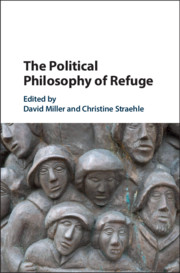Book contents
- The Political Philosophy of Refuge
- The Political Philosophy of Refuge
- Copyright page
- Contents
- Contributors
- Introduction
- Chapter 1 Differentiating Refugees
- Chapter 2 The State’s Right to Exclude Asylum-Seekers and (Some) Refugees
- Chapter 3 Asylum, Speech, and Tragedy
- Chapter 4 Border Rescue
- Chapter 5 Selecting Refugees
- Chapter 6 Refugees and the Right to Remain
- Chapter 7 The Duties of Refugees
- Chapter 8 Is Return the Preferred Solution to Refugee Crises?
- Chapter 9 Refugees and the Right to Return
- Chapter 10 Refugees, Rescue, and Choice
- Chapter 11 Philosophical Foundations for Complementary Protection
- Chapter 12 The Ethics of Sanctuary Policies in Liberal Democratic States
- Bibliography
- Index
Chapter 2 - The State’s Right to Exclude Asylum-Seekers and (Some) Refugees
Published online by Cambridge University Press: 01 November 2019
- The Political Philosophy of Refuge
- The Political Philosophy of Refuge
- Copyright page
- Contents
- Contributors
- Introduction
- Chapter 1 Differentiating Refugees
- Chapter 2 The State’s Right to Exclude Asylum-Seekers and (Some) Refugees
- Chapter 3 Asylum, Speech, and Tragedy
- Chapter 4 Border Rescue
- Chapter 5 Selecting Refugees
- Chapter 6 Refugees and the Right to Remain
- Chapter 7 The Duties of Refugees
- Chapter 8 Is Return the Preferred Solution to Refugee Crises?
- Chapter 9 Refugees and the Right to Return
- Chapter 10 Refugees, Rescue, and Choice
- Chapter 11 Philosophical Foundations for Complementary Protection
- Chapter 12 The Ethics of Sanctuary Policies in Liberal Democratic States
- Bibliography
- Index
Summary
The plight of those seeking refuge calls for action. The question this chapter considers is how far, if at all, that action should take the form of disabling states from excluding asylum-seekers or refugees. The argument of the chapter is that while states have wide-ranging responsibilities to vulnerable non-citizens, these responsibilities do not extinguish the state’s right to prevent asylum-seekers from entering its territory or to expel (some) refugees who have entered. This freedom is carefully preserved in the Refugee Convention 1951 and is important if states are to safeguard the common good which is their paramount responsibility and to decide prudently how best to discharge their responsibilities. The chapter begins by considering the distinction between citizens and non-citizens and defending the general liability of the latter to exclusion. Refugees are a special subset of non-citizens whom the Convention protects in various ways. The chapter traces these modes of protection and argues that they rightly do not eliminate the state’s freedom to deny entry to asylum-seekers or to expel some refugees. Undermining this freedom encourages refugees to become economic migrants and economic migrants to misrepresent themselves as asylum-seekers. The state’s responsibility to vulnerable non-citizens will often best be discharged by supporting other states adjacent to the country of origin. The chapter concludes by considering the significance of the atrophy of the right to exclude in the context of the European migration crisis.
- Type
- Chapter
- Information
- The Political Philosophy of Refuge , pp. 39 - 58Publisher: Cambridge University PressPrint publication year: 2019
- 1
- Cited by



